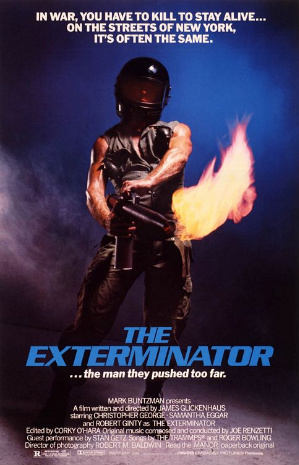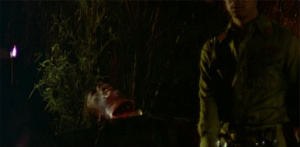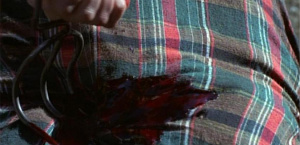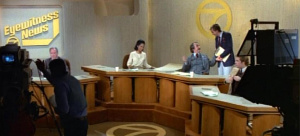
If Friday the 13th borrowed extensively from Halloween then The Exterminator stole excessively from Death Wish, Michael Winner’s 1974 vigilante thriller that made a star out of Charles Bronson. With his wife murdered and his daughter abused, Paul Kersey (Charles Bronson) set out to exact revenge against those responsible, much like George Miller’s 1979 post apocalyptic road movie Mad Max. Employing a similar premise, James Glickenhaus’ 1980 exploitation flick The Exterminator would see a Vietnam vet seeking out a group of hoodlums who had paralysed his best friend. Despite the artwork promising a protagonist clad in a motorcycle mask and brandishing a flamethrower, the film itself would feature little brutality aside from a rather severe throat slashing during the opening sequence, yet would become one of the most notorious thrillers of the early eighties.
Glickenhaus’ only prior credit as director was an obscure horror from 1975 entitled Suicide Cult and for his sophomore effort he followed the likes of Sam Peckinpah by penning a revenge flick. One major inspiration for the story was Rolling Thunder, a thriller released three years earlier that had been co-scripted by Taxi Driver‘s Paul Schrader, which told of a man returning home from war to discover that his wife has since found comfort in the arms of another man. Soon his presence seems to have angered the lover and he is brutally beaten before his wife and son are murdered. When he awakens in hospital a few weeks later, he sets out to take revenge against those who destroyed his family. Whilst Schrader’s story had focused more on the inner turmoil that the protagonist was suffering, Glickenhaus was more interested in producing a low budget exploitation feature that would achieve modest success at the drive ins and eventually find an audience on home video.

The film opens in Vietnam, where a group of American soldiers are tortured by the sadistic Viet Cong. In an effort to break the leader, John Eastland (Robert Ginty), the throat of one of their comrades is slashed open, causing the head to fall backwards to separate from the body. Desperate to escape, Eastland and Michael Jefferson (Steve James) overpower their enemy and make their way into the jungle. Years later and the two are living in New York, still haunted by the atrocities they had witnessed. Jefferson now has a family and both he and Eastland work at a food warehouse, where a local gang known as the Ghetto Ghouls attempt to rob their supplies. Eventually managing to scare away the hoodlums, Jefferson is later attacked and left paralysed in hospital, prompting Eastland to take the law into his own hands and kill the gang.
Achieving a sense of worth from his actions, Eastland sets out to clean up the streets of New York by targeting the mobsters that run a protection racket against various local businesses, including the one which he and Jefferson are employed by. Other targets include a pimp (Tony DiBenedetto) who sells the services of young children and a senator (David Lipman) who is a frequent customer. Eventually his killing spree attracts the attention of both the NYPD and the FBI, with Detective James Dalton (Christopher George) leading the investigation. Is The Exterminator a hero or a menace and can murder be punished by revenge? Eastland tries to explain to Dalton the reasons for his actions but the FBI have other ideas and soon the net begins to close around him.

Shot on location in New York, The Exterminator was one of many films in the seventies and eighties which would portray the Big Apple as cesspit. Other notable examples include Taxi Driver, Maniac, Nightmare in a Damaged Brain and Basket Case. In 1980, when the movie had its debut, America was still troubled by the events of Vietnam and the likes of First Blood, released two years later, showed the country that its soldiers had been ruined by their actions and the horror which they had witnessed. Whilst The Exterminator makes no real attempt to comment on the aftermath of the war, it would portray the soldiers as broken men, unable to cope back in civilised society (in a similar fashion to Antonio Margheriti’s Italian/American cannibal flick Apocalypse domani (Cannibal Apocalypse). The opening beheading, designed by FX legend Stan Winston, is a little too over-the-top but sets up the tone of the movie well. After all, this is an exploitation movie and not a social commentary.
The biggest flaw with The Exterminator is the artwork, which promises one thing which the film fails to deliver. Whilst Ginty’s performance is at times convincing, he fails to be menacing enough to make the scenes as sadistic as they need to be. This could have been a far more detailed and imposing character but instead he floats through the film with a troubled look on his face. But both he and James are likeable enough to demand the viewer’s sympathies and the presence of George (of Graduation Day and Pieces fame) is always a welcome addition to a horror film. Glickenhaus’ succeeds in portraying New York as a depressing and doomed city, full of worthless inhabitants, with the streets awash with pimps, prostitutes, junkies and petty criminals. Despite falling short of its own promise, The Exterminator is an intriguing and occasionally gruesome flick that boasts enough ideas to stay afloat for an hour and a half.


4 Responses to The Exterminator (1980)